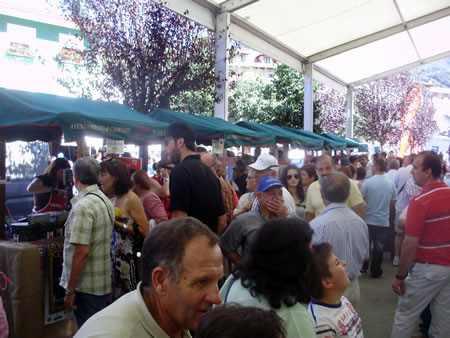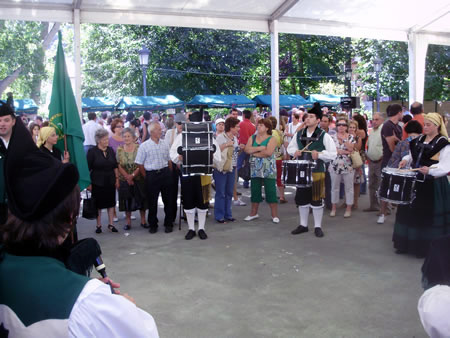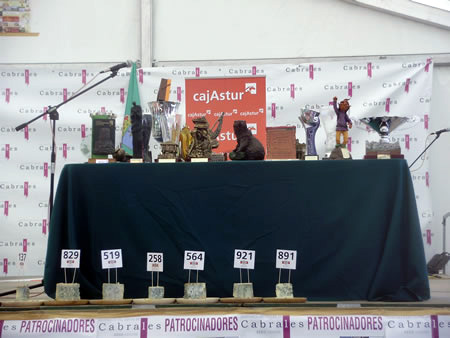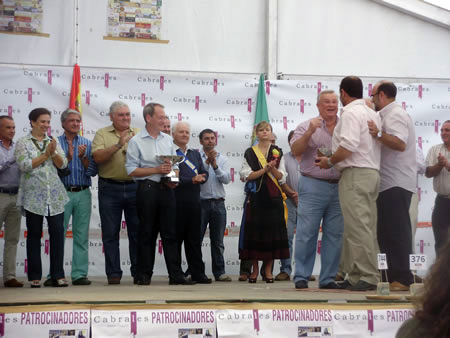Blue Cheese in Cabrales, Spain
Article and photos by Brenden Cooper
 \ \
Dave in the Cabralese cheese tasting line.
The extent of my exposure to blue cheese was in salads or salad dressing. I had no intense passion for cheeses. If you asked me before I visited Cabrales, I would have thought cheese festivals were snobbish ways for older adults to spend days gossiping behind each other's backs while pretending to be cultured.
Dave — my best friend and travel partner throughout college — and I was in Spain for a month. We did some sightseeing but mainly ate and drank through Madrid, where we stayed with Dave's Spanish roommates whom he had known from a visit two years previously. This was our last summer before the "real world" kicked in, and we started working, so naturally, we were restless and eager to get out of Madrid after the first week. Dave suggested the Asturias region in the north, and we read up on it in our 5-year-old library-borrowed guidebook, which was more of a collection of colorful photographs than practical guidance. Only one sentence indicated anything about Cabrales. The book noted that the annual cheese festival in Arenas de Cabrales, a town of 800 people, was held on the last Sunday in August. That was four days away. Upon reading this, Dave proclaimed, "We're going."
“Umm, okay,” I replied warily.
“What’s with Cabrales? Where are we staying? How are we getting there?"
"We're going."
We were 22-year-olds on a tight budget, and my skepticism about finding accessible and inexpensive hostels and transportation in this rural northern region was equal to his steadfast resolution to attend the festival. However, because this was "Dave week," when he decided on our itinerary, the best I could counter with was via a hesitant nod, taking a backseat to his whimsical planning.
Through a myriad of transport modes and transfers — a plane to Santander, a train to Oviedo, and a bus that detoured in Gijon — we arrived at a monastery converted into a hostel in Cangas de Onis, the launching point for Cabrales, where we spent the night. In the morning, we bought bread in preparation for a day of cheese. A bus took us on a 2-lane country road that wound through the Asturian countryside under the shadow of the Picos de Europa mountain range. The congestion began promptly at the sign announcing our arrival in Arenas de Cabrales. It was late morning, and hundreds of buyers and tasters were milling around the large open-air tent encircled by about 25 Cabrales cheese booths. Dave took the reins. "You go clockwise," he commanded, "I'll go in reverse." Our experience of the festival began.
It was not quite at the cheese festival I had envisioned. No well-dressed older couples were sticking their noses at me. All lovers of Cabrales cheese reveled in this annual tradition, the XXXIX Festival del Queso de Cabrales, or the 39th Cabrales Cheese Festival.
Cabrales is not your commercial, mass-produced blue cheese. It is like beer from a local microbrewery in its craft and attention but world-class as a product. The taste is too unique and powerful to create any potential demand for mass consumption, even if the producers decide to go that route, which they do not. The cheese production is family-run, family-owned, and generations old. The festival gave off such a local and neighborly aura that I would not be surprised if the goats and sheep — with the cheese created from their milk — had been inbred for decades. The cheese-producing entities are unflappably permanent. When external economic forces bring down the last of the corner pharmacies, small cattle ranches, and independent bookstores, Cabrales will endure. For any corporation that even wanted to buy up Cabrales, the profits may not be significant enough, the market may not be big enough, but above all, the passion, livelihood, and definition of the entire community is Cabrales cheese. The community would never part with it.
I wedged between two couples debating the merits of a cheese far across the room and Number One's cheese, presented in front of me. A young girl, no older than 13, who I took to be Number One's daughter, gave me my first sample. She cut a thin slice off the cumbersome wheel with a wieldy 10-inch blade and offered the knife in my direction. I slid the sliver off the knife with my pinky, mimicking the man beside me. Most blue cheeses are sticky, but Cabrales is especially so — to the point where after multiple licks of my fingers, I could only clumsily pick out a bill from my wallet to pay for the necessary bubbly water. I was unsure whether to suck or chew on the semi-soft substance, so I rolled it around the inside of my mouth, coating it with a thick layer of Cabrales. The girl raised her eyebrows and let out a high-pitched questioning grunt as if to say, Good, eh? I nodded and smiled in approval. It was divine.
I picked up a brochure that described the process of Cabrales cheese-making. The distinguishing feature of the production is that Cabrales is cured in caves. They let it sit in the caves for months. Cabrales is genuinely one of a kind, using the naturally formed uneven topography of the adjacent Picos de Europa. It tasted like it had been kept under containment, like a genie in a bottle, only to unleash its full power when released.
Pungent is a euphemism. I drank some bubbly water to cleanse my palette for the next tasting. The cheese still lingered, the fresh mountain air only suffusing it further into my taste buds. I breathed in Cabrales. I breathed out Cabrales. It was not an unpleasant feeling, except that I wanted to be able to taste the next cheese!
Cheese booth Number Two belonged to a dairy farmer, as shown in the "How to Look like a Dairy Farmer" guide. He was a portly, balding man with a broad, welcoming smile. His booth was more popular than Number One's, and he had moved on to the next sampler before he could watch for my reaction. I could not tell the difference between Number Two's cheese and Number One's. I was hoping to rank my favorite cheeses; with his culinary experience superiority, I knew Dave would be telling me which ones to try, and I had to have a comeback.
I sulked over to booth Number Three. To my delight, I could tell the difference: Number Three's cheese had a duller flavor. It may have been taken out of the cave too early because the farmer was eager to get it to the market. It struck me briefly that generating a more subtle Cabrales could have been intentional. However, the characters and personalities in the tent led me to believe that they followed the mantra: the moldier, the better.
I wandered from booth to booth, clockwise as instructed, finding each Cabrales variation only slightly distinctive until I reached booth Number Eight. The owner was a slick-looking grey-haired man wearing a white-striped blue button-down shirt tucked into his aqua light green pants. He exuded perfection. I put my pinky to my lips and rejoiced in a favorite Cabrales. The cheese expelled an overpowering sweetness to battle the more traditional Cabrales pungency. I exhaled in glory.
“El mejor!” I told him his cheese was the best in Spanish. Perhaps recognizing my accent, he asked me where I was from. "America," I responded.
"Ah, America. Los Angeles Lakers, my favorite!" he joked in English with a hearty chuckle. I had gotten this before — but from a dairy farmer in rural Spain, a reference so close to home threw me for a heavier-than-usual laugh.
Finishing off my half of the tent's circle, I concluded that what I tasted in booth Number Eight would be the cheese I would speak of to Dave. I spotted his 6-foot-five frame above the crowd as he stood in line for his final tasting. Before I could get to him, the crowd started to disperse toward the outer edges of the tent's center. Drummers looking like they belonged in a Celtic college marching band came to the center to play. They yielded to dancers, similarly dressed and performing a jig-type dance. I later learned Asturias had a considerable Celtic influence from the ancient Astur people. This was a prelude to the award presentation, which would commence in 15 minutes.
 \ \
Let the Cabralese cheese festival celebration begin.
I waved to Dave from across the tent. We gave hand signals to each other, and I pointed to Number Eight’s booth, while he motioned toward two of his favorites. Ten pinky slivers of the dense cheese were far too much, but this was the Festival of Cabrales! I snaked my way through the crowd and sampled his two recommendations. At one booth, I met the host of Number Fourteen, a jolly, Santa Claus-esque man whose cheese was remarkably unique. It had a sour, almost grapefruit flavor, like it had almost given up in the cave before being resuscitated to be marked for consumption.
Dave and I reconvened after the dancing finished. Still holding our long baguette from Cangas, there was clearly a need for more Cabrales. From his stern expression, I saw he would be distraught if we did not buy one of his cheeses. I did not even argue; I had traveled with him too much to know his preferences regarding food were far more intense than mine. He cried after leaving our favorite pizza place in Croatia. Plus, it was "Dave week." We bought a sizeable block of Number Fourteen's cheese.
People crammed into the tent for the ceremony. The emcee recited the obligatory thanks for the festival to the sponsor bank, CajAstur, and the event organizers. He then announced the "Xana," which meant a beautiful nymph in Asturian mythology. A gorgeous, cheery young woman with long blonde hair, a silk dress, and a sash appeared from backstage and took a curtsy; maybe Cabrales's xana was like a homecoming queen from my upbringing in the U.S.
After some honorary, predetermined awards were presented to various members of the Cabrales cheese community, a pause was taken for the cheeses and trophies to be brought forth. Fourteen wheels of cheese were lined up downstage with 3-digit numbers attached to them, and what appeared to be 14 various trophies were placed on a table upstage. I had yet to learn what 14 awards could be for. Tastiest? Most filling? Smoothest?
 \ \
Presenting the Cabralese cheese winners.
The emcee came back to the mic. "The fourteenth ranked cheese, from Carreña…" One farmer lumbered up to the stage, kissed the xana on both cheeks, took the trophy resembling a bear, and posed for a photo with the head of the Cabrales cheese producers associated with a broad grin. He didn't seem to care. He got a fourteenth place. Dave and I shook our heads at the situation's absurdity: counting down the 14 best cheeses would take an hour.
The trophies, which were various hoisted metal objects ranging from some ancient knight to a saucer to a scroll, continued to be given out. Each winner was dressed as you would expect a dairy farmer to dress up for their most important day of the year: in vibrant, trim outfits that may have been overgrown in recent years but still capable of being wrestled into. They accepted their awards, one by one, unsure where to stand and how to act. One man stood facing the applause, hands by his side, and quizzically peered at the crowd, wondering what the fuss was about. None had a stage presence, which made them real. I could visualize my father, unaccustomed to the public eye, as one of the dairy farmers stumbling upstairs and awkwardly being led around to do his various onstage duties.
 \ \
Presentation to the Cabrales cheese winner.
My favorite, Number Eight, finished sixth with the aqua light green pants. Number Fourteen's cheese, which we purchased, went right after in fifth place. Finally, the aforementioned head of the Cabrales Producers Association announced the winner. I didn't recognize him; it was hard to match the cheeses with the faces, especially when family members were involved with the tastings. He pumped his fists upward in victory and embraced the xana. Then, it was announced that his winning cheese wheel had received an auction price of 3,075 Euros, or over US$3,200. The applause shook the tent as the strutting buyer, whose walk reminded me of a Russian oligarch, took the cheese wheel and posed with his new Cabrales prize.
In conclusion, the emcee introduced the two rival political figures of the Cabrales municipality, and they embraced each other.
"… For today, we forget about our conflicts and differences," he declared, "and celebrate our commonality of the best cheese in the world: queso de Cabrales." Dave and I again glanced at each other in disbelief. With the municipality's population just over 2,000, the bitter conflicts that ensued throughout the year couldn't have been too upsetting.
The warm moment led to a warm afternoon, and we retired to a shady, grassy spot next to a calm brook. Naked toddlers rolled around near the shore, and several families surrounded us, also picnicking. Everybody ate Cabrales and bread. Downtown would be blocked off for festivities, and families would seek out the park for a hiatus from the hubbub. It could be any town in the world, brought together by a familiar music, art, or theme that made families leave their houses for a day and form this intangible concept of a community. I listened to the sounds still coming from the cheese tent. I imagined the winner drinking to the 14-place finisher.
I was on this quest to see the world and "get cultured" before it was too late. Of course, we went to the Prado in Madrid and saw the Alhambra in Granada. The sunburned tourists spoke English, were immersed in their guidebooks, and appreciated, or at least appeared to enjoy the art and culture they were privileged to experience. The museums were interesting and attractive, but I attached little meaning to these places on this trip. Was I missing something? Was I not capable of identifying with other cultures?
But what was my own culture? I could not share my unique upbringing and enthralling story with those I met because I did not have one. You could say I was raised "normal." I realized then that the way to "get cultured" and relate to other lands and people was to find similarities. My homecoming queen and their xana. My Wells Fargo and their CajAstur. My tennis trophies and their cheese trophies. My family and their family. I should have further valued Spanish art, deeply comprehended Spanish history, and appreciated Spanish architecture. Yet, that day, I felt that I understood the Spanish people. In many way, they seemed just like me.
Brenden Cooper is a graduate student in Economics at the University of Minnesota and continues pursuing writing as a hobby and a possible career path.
|
